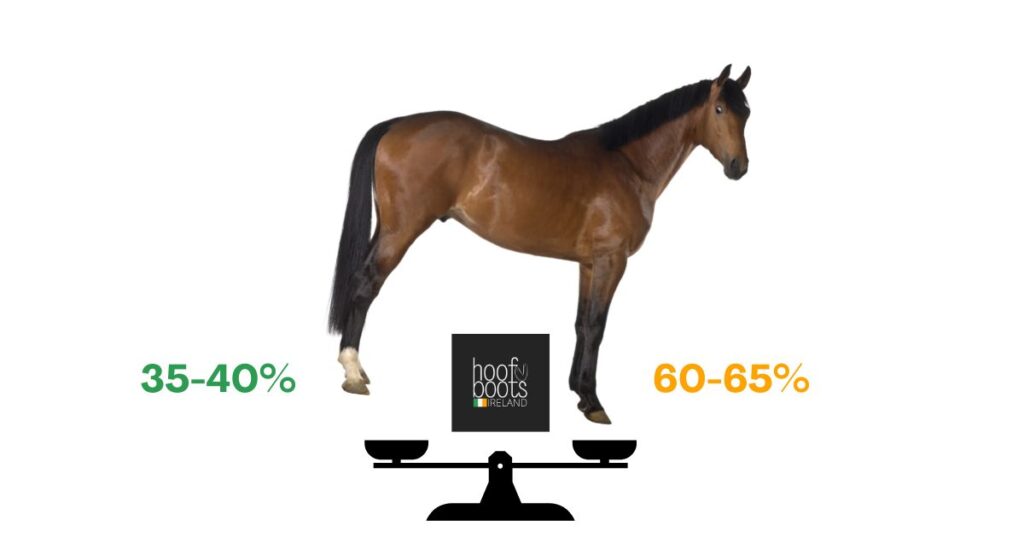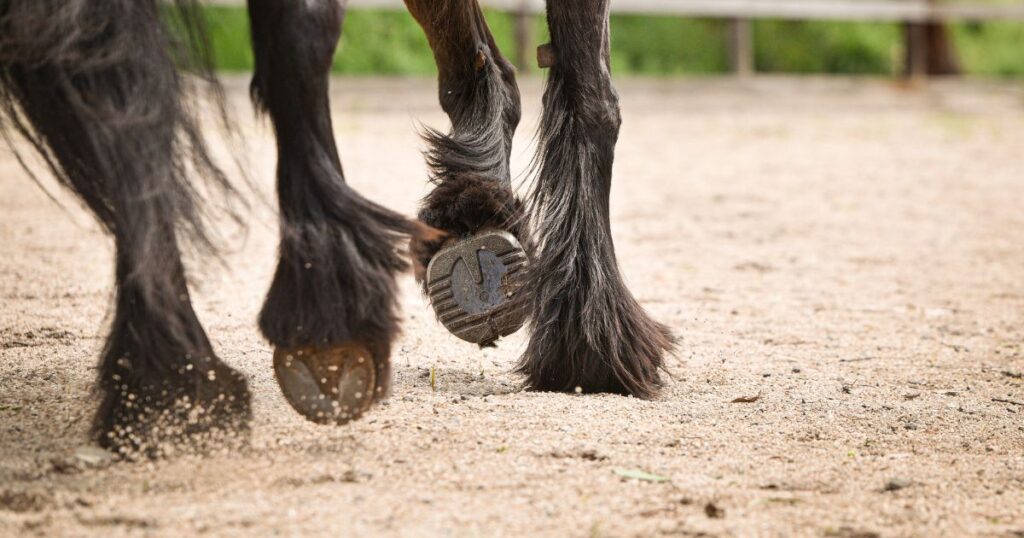Before we consider how many boots your horse may need, let’s take a look at the balance of the horse.

Horses are naturally downhill, so their forelimbs support the majority of their weight. Because they carry between 60 and 65 percent of their weight up front, a horse puts more strain on its front limbs than on its back limbs. If horses are uncomfortable on their front hooves, it can lead to lameness, behavioural issues or other health issues from the prolonged altered posture.
How can hoof boots help your horse find their natural balance?
Hoof boots are a type of protective footwear designed to be worn by horses. They can provide support, cushioning, and protection for the horse’s hooves, particularly in situations where traditional horseshoes may not be practical or desirable.
When the horse is more comfortable on the front hooves as a result of the extra protection and cushioning they are more likely to carry their weight on the front limbs, enabling natural posture and movement. For this reason, most horses only require front hoof boots, but there are a few key points you may want to factor in if choosing front-only or all-around booting.
Acute lameness
Acute lameness may be from acute inflammation or sudden injury, which requires immediate relief and treatment from a qualified veterinarian. Ensuring a horse with acute lameness is comfortable on all hooves is paramount for them to maintain correct posture and increase movement for proper circulation and lymphatic drainage. Recovery and therapy boots are useful in times of acute lameness.
Chronic pathology
Horse hoof pathology refers to any condition or disease that affects the hoof of a horse. Some common hoof pathologies include laminitis, navicular syndrome, white line disease, and thrush. These will require longer-term support but in many cases, the hoof health can improve over time. If health issues are missed or go untreated for a prolonged period the hoof may be affected. Boney changes may occur in the pedal bone to compensate for issues elsewhere in the body which permanently affects the shape of the hoof and requires a plan of support. In cases of long-term pathology, we recommend a TATH – team around the horse. This usually includes the trimmer/farrier, vet, physio and hoof boot fitter – this combination of professionals working together can ensure the horse has the correct support and make changes at key stages to support recovery.
Poor hoof health
If your horse has been shod on the hind hooves (or indeed the front also) for a prolonged period, you may notice that the frog and other structures at the back of the hoof are poorly developed. This could also manifest as underrun heels, soreness behind and also stiff pelvic and hind limb motion. Hoof boots in this instance could be seen as a temporary solution to supporting the horse in getting back on its feet (pardon the pun). Once the horse’s hooves are more comfortable the hind boots can slowly transition to barefoot where possible. Bear in mind, sometimes the development can take years to repair and depends on age, health history, diet, trim and management.
Growth vs Wear
Not all hooves require boots because of pain or pathology. Hooves are very responsive to change, but they can take time to adjust to wear. It’s a common complaint that the hooves wear down too quickly. This is because the hoof may not be used to covering as much hard ground – maybe they are kept on grass or that they are only hacking a few Km per week but then the workload suddenly becomes greater and the hoof horn is soft from being kept on moist ground. When the ground is harder, the horn becomes harder and as the workload slowly increases, the hooves grow faster to accommodate. Diet will also greatly impact on the quality of the hoof horn being grown ad should be taken in to account in the transition.
If you wish to increase the workload, hoof boots allow you to increase workloads in wetter climates without the worry of the hooves wearing too quickly. Removing the boots for short periods, and gradually increasing their means the hoof can acclimatise with the workload and is part of our recommendations to transition to barefoot where possible.
How do I know if my horse requires hind boots?
If your horse is generally sound with front boots but the hinds are still uncomfortable on stones or uneven ground or you need to increase the workload and you don’t think the hooves are growing fast enough to accommodate, we recommend hind boots as a temporary solution, but emphasise that any unsoundness or lameness should be investigated (in any/all hooves).
Usually, acute lameness presents quite obviously with limp or severe behaviour changes such as bucking, rearing or even bolting. If you suspect lameness, acute or otherwise this needs to be diagnosed by a vet. A vet may take xrays of the hooves. We can look at these reports and make recommendations for the required boots.
The bottom line is, we believe a healthy horse with healthy hooves should not require hoof boots, but hoof boots provide the necessary protection for hooves that are recovering and allow the horse to continue to be exercised/hacked out.

